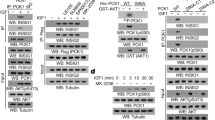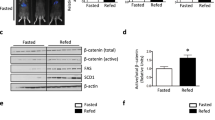Abstract
Glucose flux through the hexosamine biosynthetic pathway leads to the post-translational modification of cytoplasmic and nuclear proteins by O-linked β-N-acetylglucosamine (O-GlcNAc). This tandem system serves as a nutrient sensor to couple systemic metabolic status to cellular regulation of signal transduction, transcription, and protein degradation. Here we show that O-GlcNAc transferase (OGT) harbours a previously unrecognized type of phosphoinositide-binding domain. After induction with insulin, phosphatidylinositol 3,4,5-trisphosphate recruits OGT from the nucleus to the plasma membrane, where the enzyme catalyses dynamic modification of the insulin signalling pathway by O-GlcNAc. This results in the alteration in phosphorylation of key signalling molecules and the attenuation of insulin signal transduction. Hepatic overexpression of OGT impairs the expression of insulin-responsive genes and causes insulin resistance and dyslipidaemia. These findings identify a molecular mechanism by which nutritional cues regulate insulin signalling through O-GlcNAc, and underscore the contribution of this modification to the aetiology of insulin resistance and type 2 diabetes.
This is a preview of subscription content, access via your institution
Access options
Subscribe to this journal
Receive 51 print issues and online access
$199.00 per year
only $3.90 per issue
Buy this article
- Purchase on Springer Link
- Instant access to full article PDF
Prices may be subject to local taxes which are calculated during checkout





Similar content being viewed by others
References
Zimmet, P., Alberti, K. G. & Shaw, J. Global and societal implications of the diabetes epidemic. Nature 414, 782–787 (2001)
Spiegelman, B. M. & Flier, J. S. Obesity and the regulation of energy balance. Cell 104, 531–543 (2001)
Lazar, M. A. How obesity causes diabetes: not a tall tale. Science 307, 373–375 (2005)
Taylor, S. I. Deconstructing type 2 diabetes. Cell 97, 9–12 (1999)
Saltiel, A. R. & Kahn, C. R. Insulin signalling and the regulation of glucose and lipid metabolism. Nature 414, 799–806 (2001)
Cantley, L. C. The phosphoinositide 3-kinase pathway. Science 296, 1655–1657 (2002)
Shepherd, P. R., Withers, D. J. & Siddle, K. Phosphoinositide 3-kinase: the key switch mechanism in insulin signalling. Biochem. J. 333, 471–490 (1998)
Hawkins, P. T., Anderson, K. E., Davidson, K. & Stephens, L. R. Signalling through Class I PI3Ks in mammalian cells. Biochem. Soc. Trans. 34, 647–662 (2006)
Saltiel, A. R. & Pessin, J. E. Insulin signaling pathways in time and space. Trends Cell Biol. 12, 65–71 (2002)
Asante-Appiah, E. & Kennedy, B. P. Protein tyrosine phosphatases: the quest for negative regulators of insulin action. Am. J. Physiol. Endocrinol. Metab. 284, E663–E670 (2003)
Lazar, D. F. & Saltiel, A. R. Lipid phosphatases as drug discovery targets for type 2 diabetes. Nature Rev. Drug Discov. 5, 333–342 (2006)
Zick, Y. Ser/Thr phosphorylation of IRS proteins: a molecular basis for insulin resistance. Sci. STKE 2005, pe4 (2005)
White, M. F. IRS proteins and the common path to diabetes. Am. J. Physiol. Endocrinol. Metab. 283, E413–E422 (2002)
Torres, C. R. & Hart, G. W. Topography and polypeptide distribution of terminal N-acetylglucosamine residues on the surfaces of intact lymphocytes. Evidence for O-linked GlcNAc. J. Biol. Chem. 259, 3308–3317 (1984)
Love, D. C. & Hanover, J. A. The hexosamine signaling pathway: deciphering the ‘O-GlcNAc code’. Sci. STKE 2005, re13 (2005)
Gao, Y., Wells, L., Comer, F. I., Parker, G. J. & Hart, G. W. Dynamic O-glycosylation of nuclear and cytosolic proteins: cloning and characterization of a neutral, cytosolic β-N-acetylglucosaminidase from human brain. J. Biol. Chem. 276, 9838–9845 (2001)
Kreppel, L. K., Blomberg, M. A. & Hart, G. W. Dynamic glycosylation of nuclear and cytosolic proteins. Cloning and characterization of a unique O-GlcNAc transferase with multiple tetratricopeptide repeats. J. Biol. Chem. 272, 9308–9315 (1997)
Toleman, C., Paterson, A. J., Whisenhunt, T. R. & Kudlow, J. E. Characterization of the histone acetyltransferase (HAT) domain of a bifunctional protein with activable O-GlcNAcase and HAT activities. J. Biol. Chem. 279, 53665–53673 (2004)
Yang, X. et al. O-linkage of N-acetylglucosamine to Sp1 activation domain inhibits its transcriptional capability. Proc. Natl Acad. Sci. USA 98, 6611–6616 (2001)
Yang, X., Zhang, F. & Kudlow, J. E. Recruitment of O-GlcNAc transferase to promoters by corepressor mSin3A: coupling protein O-GlcNAcylation to transcriptional repression. Cell 110, 69–80 (2002)
Zhang, F. et al. O-GlcNAc modification is an endogenous inhibitor of the proteasome. Cell 115, 715–725 (2003)
Wells, L., Vosseller, K. & Hart, G. W. Glycosylation of nucleocytoplasmic proteins: signal transduction and O-GlcNAc. Science 291, 2376–2378 (2001)
Buse, M. G. Hexosamines, insulin resistance, and the complications of diabetes: current status. Am. J. Physiol. Endocrinol. Metab. 290, E1–E8 (2006)
Musicki, B., Kramer, M. F., Becker, R. E. & Burnett, A. L. Inactivation of phosphorylated endothelial nitric oxide synthase (Ser-1177) by O-GlcNAc in diabetes-associated erectile dysfunction. Proc. Natl Acad. Sci. USA 102, 11870–11875 (2005)
Hanover, J. A. et al. A Caenorhabditis elegans model of insulin resistance: altered macronutrient storage and dauer formation in an OGT-1 knockout. Proc. Natl Acad. Sci. USA 102, 11266–11271 (2005)
Lehman, D. M. et al. A single nucleotide polymorphism in MGEA5 encoding O-GlcNAc-selective N-acetyl-β-D glucosaminidase is associated with type 2 diabetes in Mexican Americans. Diabetes 54, 1214–1221 (2005)
Majumdar, G. et al. Insulin stimulates and diabetes inhibits O-linked N-acetylglucosamine transferase and O-glycosylation of Sp1. Diabetes 53, 3184–3192 (2004)
Konrad, R. J. & Kudlow, J. E. The role of O-linked protein glycosylation in beta-cell dysfunction. Int. J. Mol. Med. 10, 535–539 (2002)
McClain, D. A. et al. Altered glycan-dependent signaling induces insulin resistance and hyperleptinemia. Proc. Natl Acad. Sci. USA 99, 10695–10699 (2002)
Vosseller, K., Wells, L., Lane, M. D. & Hart, G. W. Elevated nucleocytoplasmic glycosylation by O-GlcNAc results in insulin resistance associated with defects in Akt activation in 3T3–L1 adipocytes. Proc. Natl Acad. Sci. USA 99, 5313–5318 (2002)
Roos, M. D. et al. Streptozotocin, an analog of N-acetylglucosamine, blocks the removal of O-GlcNAc from intracellular proteins. Proc. Assoc. Am. Physicians 110, 422–432 (1998)
Haltiwanger, R. S., Holt, G. D. & Hart, G. W. Enzymatic addition of O-GlcNAc to nuclear and cytoplasmic proteins. Identification of a uridine diphospho-N-acetylglucosamine:peptide β-N-acetylglucosaminyltransferase. J. Biol. Chem. 265, 2563–2568 (1990)
Wang, J., Liu, R., Hawkins, M., Barzilai, N. & Rossetti, L. A nutrient-sensing pathway regulates leptin gene expression in muscle and fat. Nature 393, 684–688 (1998)
Liu, K., Paterson, A. J., Chin, E. & Kudlow, J. E. Glucose stimulates protein modification by O-linked GlcNAc in pancreatic beta cells: linkage of O-linked GlcNAc to beta cell death. Proc. Natl Acad. Sci. USA 97, 2820–2825 (2000)
Yki-Jarvinen, H., Virkamaki, A., Daniels, M. C., McClain, D. & Gottschalk, W. K. Insulin and glucosamine infusions increase O-linked N-acetyl-glucosamine in skeletal muscle proteins in vivo. Metabolism 47, 449–455 (1998)
Wells, L., Vosseller, K. & Hart, G. W. A role for N-acetylglucosamine as a nutrient sensor and mediator of insulin resistance. Cell. Mol. Life Sci. 60, 222–228 (2003)
Zachara, N. E. & Hart, G. W. O-GlcNAc a sensor of cellular state: the role of nucleocytoplasmic glycosylation in modulating cellular function in response to nutrition and stress. Biochim. Biophys. Acta 1673, 13–28 (2004)
Whisenhunt, T. R. et al. Disrupting the enzyme complex regulating O-GlcNAcylation blocks signaling and development. Glycobiology 16, 551–563 (2006)
Chen, M. X. & Cohen, P. T. Activation of protein phosphatase 5 by limited proteolysis or the binding of polyunsaturated fatty acids to the TPR domain. FEBS Lett. 400, 136–140 (1997)
Arias, E. B., Kim, J. & Cartee, G. D. Prolonged incubation in PUGNAc results in increased protein O-linked glycosylation and insulin resistance in rat skeletal muscle. Diabetes 53, 921–930 (2004)
D’Alessandris, C. et al. Increased O-glycosylation of insulin signaling proteins results in their impaired activation and enhanced susceptibility to apoptosis in pancreatic beta-cells. FASEB J. 18, 959–961 (2004)
Park, S. Y., Ryu, J. & Lee, W. O-GlcNAc modification on IRS-1 and Akt2 by PUGNAc inhibits their phosphorylation and induces insulin resistance in rat primary adipocytes. Exp. Mol. Med. 37, 220–229 (2005)
Ongusaha, P. P. et al. p53 induction and activation of DDR1 kinase counteract p53-mediated apoptosis and influence p53 regulation through a positive feedback loop. EMBO J. 22, 1289–1301 (2003)
Krugmann, S. et al. Identification of ARAP3, a novel PI3K effector regulating both Arf and Rho GTPases, by selective capture on phosphoinositide affinity matrices. Mol. Cell 9, 95–108 (2002)
Furukawa, N. et al. Role of Rho-kinase in regulation of insulin action and glucose homeostasis. Cell Metab. 2, 119–129 (2005)
Joost, H. G. & Schurmann, A. Subcellular fractionation of adipocytes and 3T3–L1 cells. Methods Mol. Biol. 155, 77–82 (2001)
Su, K., Yang, X., Roos, M. D., Paterson, A. J. & Kudlow, J. E. Human Sug1/p45 is involved in the proteasome-dependent degradation of Sp1. Biochem. J. 348, 281–289 (2000)
Miles, P. D., Barak, Y., He, W., Evans, R. M. & Olefsky, J. M. Improved insulin-sensitivity in mice heterozygous for PPAR-γ deficiency. J. Clin. Invest. 105, 287–292 (2000)
Suzuki, Y. et al. Insulin control of glycogen metabolism in knockout mice lacking the muscle-specific protein phosphatase PP1G/RGL. Mol. Cell. Biol. 21, 2683–2694 (2001)
Norris, A. W. et al. Muscle-specific PPARγ-deficient mice develop increased adiposity and insulin resistance but respond to thiazolidinediones. J. Clin. Invest. 112, 608–618 (2003)
Acknowledgements
We thank T. Hunter, B. Burgering, J. Yuan and O. Gozani for providing reagents; R. Shaw for advice; R. Shaw, S. Dove and H. Cho for critical reading of the manuscript; Z. Wu for help with statistical analysis; M. Nelson and K. Kawamura for technical assistance; and L. Ong and S. Ganley for administrative assistance. X.Y. is the recipient of a Ruth L. Kirschstein National Research Service Award Individual Fellowship. R.M.E. is an Investigator of the Howard Hughes Medical Institute at the Salk Institute and March of Dimes Chair in Molecular and Developmental Biology. R.M.E. is supported by grants from the Howard Hughes Medical Institute and the NIH (National Institute of Diabetes and Digestive and Kidney Diseases, and Nuclear Receptor Signaling Atlas). J.M.O. is supported by NIH grants and a University of California Discovery BioStar grant with matching funds from Pfizer Incorporated. S.J.F. is supported by grants from the Burroughs Wellcome Fund, the V Foundation, and the NIH.
Author Contributions X.Y. conceived the project, designed and performed most of the experiments. P.P.O. and S.J.F. participated in protein–lipid binding and cell imaging experiments. P.D.M. performed hyperinsulinaemic–euglycaemic glucose clamp studies. J.C.H. assisted in biochemical and animal experiments. F.Z. performed OGT activity assays. W.V.S. performed bioinformatic analyses. J.M.O., R.H.M., J.E.K. and S.J.F. provided intellectual input and technical expertise. R.M.E. supervised the project. X.Y. and R.M.E. wrote the manuscript.
Author information
Authors and Affiliations
Corresponding author
Ethics declarations
Competing interests
J.M.O. is a consultant for Pfizer Incorporated.
Supplementary information
Supplementary Information
The file contains Supplementary Figures S1-S21 with Legends, Legends to Supplementary Movies 1-6, and Supplementary Methods. (PDF 678 kb)
Supplementary Movie 1
This file contains Supplementary Movie 1 (MOV 472 kb)
Supplementary Movie 2
This file contains Supplementary Movie 2 (MOV 1419 kb)
Supplementary Movie 3
This file contains Supplementary Movie 3 (MOV 1428 kb)
Supplementary Movie 4
This file contains Supplementary Movie 4 (MOV 529 kb)
Supplementary Movie 5
This file contains Supplementary Movie 5 (MOV 939 kb)
Supplementary Movie 6
This file contains Supplementary Movie 6 (MOV 656 kb)
Rights and permissions
About this article
Cite this article
Yang, X., Ongusaha, P., Miles, P. et al. Phosphoinositide signalling links O-GlcNAc transferase to insulin resistance. Nature 451, 964–969 (2008). https://doi.org/10.1038/nature06668
Received:
Accepted:
Issue Date:
DOI: https://doi.org/10.1038/nature06668
This article is cited by
-
Acute stress induces long-term metabolic, functional, and structural remodeling of the heart
Nature Communications (2023)
-
Phosphoinositides and intracellular calcium signaling: novel insights into phosphoinositides and calcium coupling as negative regulators of cellular signaling
Experimental & Molecular Medicine (2023)
-
Candesartan, an angiotensin-II receptor blocker, ameliorates insulin resistance and hepatosteatosis by reducing intracellular calcium overload and lipid accumulation
Experimental & Molecular Medicine (2023)
-
Identification of genetic variants affecting reproduction traits in Vrindavani cattle
Mammalian Genome (2023)
-
Protein O-GlcNAcylation and the regulation of energy homeostasis: lessons from knock-out mouse models
Journal of Biomedical Science (2022)
Comments
By submitting a comment you agree to abide by our Terms and Community Guidelines. If you find something abusive or that does not comply with our terms or guidelines please flag it as inappropriate.



